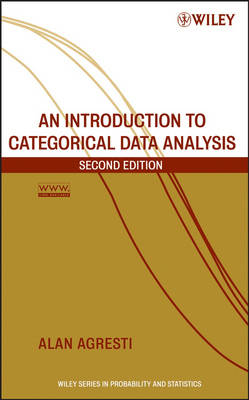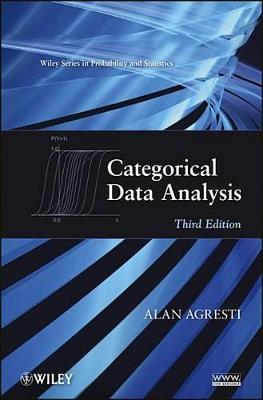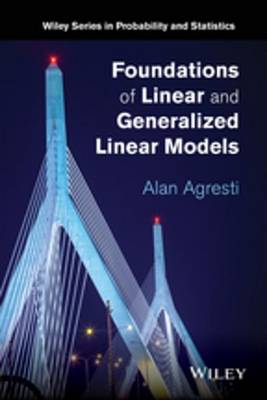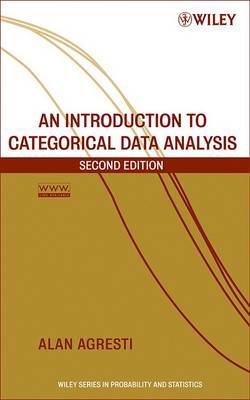Wiley Series in Probability and Statistics
3 primary works • 5 total works
Book 423
Praise for the First Edition "This is a superb text from which to teach categorical data analysis, at a variety of levels...[t]his book can be very highly recommended." -Short Book Reviews "Of great interest to potential readers is the variety of fields that are represented in the examples: health care, financial, government, product marketing, and sports, to name a few." -Journal of Quality Technology "Alan Agresti has written another brilliant account of the analysis of categorical data." -The Statistician The use of statistical methods for categorical data is ever increasing in today's world. An Introduction to Categorical Data Analysis, Second Edition provides an applied introduction to the most important methods for analyzing categorical data. This new edition summarizes methods that have long played a prominent role in data analysis, such as chi-squared tests, and also places special emphasis on logistic regression and other modeling techniques for univariate and correlated multivariate categorical responses.
This Second Edition features:* Two new chapters on the methods for clustered data, with an emphasis on generalized estimating equations (GEE) and random effects models* A unified perspective based on generalized linear models* An emphasis on logistic regression modeling* An appendix that demonstrates the use of SAS(r) for all methods* An entertaining historical perspective on the development of the methods* Specialized methods for ordinal data, small samples, multicategory data, and matched pairs* More than 100 analyses of real data sets and nearly 300 exercises Written in an applied, nontechnical style, the book illustrates methods using a wide variety of real data, including medical clinical trials, drug use by teenagers, basketball shooting, horseshoe crab mating, environmental opinions, correlates of happiness, and much more. An Introduction to Categorical Data Analysis, Second Edition is an invaluable tool for social, behavioral, and biomedical scientists, as well as researchers in public health, marketing, education, biological and agricultural sciences, and industrial quality control.
This Second Edition features:* Two new chapters on the methods for clustered data, with an emphasis on generalized estimating equations (GEE) and random effects models* A unified perspective based on generalized linear models* An emphasis on logistic regression modeling* An appendix that demonstrates the use of SAS(r) for all methods* An entertaining historical perspective on the development of the methods* Specialized methods for ordinal data, small samples, multicategory data, and matched pairs* More than 100 analyses of real data sets and nearly 300 exercises Written in an applied, nontechnical style, the book illustrates methods using a wide variety of real data, including medical clinical trials, drug use by teenagers, basketball shooting, horseshoe crab mating, environmental opinions, correlates of happiness, and much more. An Introduction to Categorical Data Analysis, Second Edition is an invaluable tool for social, behavioral, and biomedical scientists, as well as researchers in public health, marketing, education, biological and agricultural sciences, and industrial quality control.
Book 482
Categorical Data Analysis describes the most important methods, offering a unified presentation of modeling using generalized linear models and emphasizing loglinear and logit modeling techniques. Contributions of noted statisticians (Pearson, Yule, Fisher, Neyman, Cochran), whose pioneering efforts set the pace for the evolution of modern methods, are examined as well.
Special features of the book include: Coverage of methods for repeated measurement data, which have become increasingly important in biomedical applications Prescriptions for how ordinal variables should be treated differently than nominal variables Derivations of basic asymptotic and fixed-sample-size inferential methods Discussion of exact small sample procedures More than 40 examples of analyses of "real" data sets, including: aspirin use and heart disease; job satisfaction and income; seat belt use and injuries in auto accidents; and predicting outcomes of baseball games More than 400 exercises to facilitate interpretation and application of methods Categorical Data Analysis also contains an appendix that describes the use of computer software currently available for performing the analyses presented in the book. A comprehensive bibliography and notes and the end of each chapter round out the work, making it a complete, invaluable reference for statisticians, biostatisticians and professional researchers.
Special features of the book include: Coverage of methods for repeated measurement data, which have become increasingly important in biomedical applications Prescriptions for how ordinal variables should be treated differently than nominal variables Derivations of basic asymptotic and fixed-sample-size inferential methods Discussion of exact small sample procedures More than 40 examples of analyses of "real" data sets, including: aspirin use and heart disease; job satisfaction and income; seat belt use and injuries in auto accidents; and predicting outcomes of baseball games More than 400 exercises to facilitate interpretation and application of methods Categorical Data Analysis also contains an appendix that describes the use of computer software currently available for performing the analyses presented in the book. A comprehensive bibliography and notes and the end of each chapter round out the work, making it a complete, invaluable reference for statisticians, biostatisticians and professional researchers.
Book 656
Statistical science's first coordinated manual of methods for analyzing ordered categorical data presents applications and case studies in fields as diverse as sociology, public health, ecology, marketing, and pharmacy. Analysis of Ordinal Categorical Data provides an introduction to basic descriptive and inferential methods for categorical data and gives thorough coverage of late developments. Special emphasis is placed on interpretation and application of methods including an integrated comparison of the available strategies for analyzing ordinal data. The book also discusses implementation of methods using computer packages such as SAS, SPSSx, and GLIM.
A valuable overview of the most important ideas and results in statistical modeling Written by a highly-experienced author, Foundations of Linear and Generalized Linear Models is a clear and comprehensive guide to the key concepts and results of linearstatistical models. The book presents a broad, in-depth overview of the most commonly usedstatistical models by discussing the theory underlying the models, R software applications,and examples with crafted models to elucidate key ideas and promote practical modelbuilding. The book begins by illustrating the fundamentals of linear models, such as how the model-fitting projects the data onto a model vector subspace and how orthogonal decompositions of the data yield information about the effects of explanatory variables. Subsequently, the book covers the most popular generalized linear models, which include binomial and multinomial logistic regression for categorical data, and Poisson and negative binomial loglinear models for count data.
Focusing on the theoretical underpinnings of these models, Foundations ofLinear and Generalized Linear Models also features: * An introduction to quasi-likelihood methods that require weaker distributional assumptions, such as generalized estimating equation methods * An overview of linear mixed models and generalized linear mixed models with random effects for clustered correlated data, Bayesian modeling, and extensions to handle problematic cases such as high dimensional problems * Numerous examples that use R software for all text data analyses * More than 400 exercises for readers to practice and extend the theory, methods, and data analysis * A supplementary website with datasets for the examples and exercises An invaluable textbook for upper-undergraduate and graduate-level students in statistics and biostatistics courses, Foundations of Linear and Generalized Linear Models is also an excellent reference for practicing statisticians and biostatisticians, as well as anyone who is interested in learning about the most important statistical models for analyzing data.
Focusing on the theoretical underpinnings of these models, Foundations ofLinear and Generalized Linear Models also features: * An introduction to quasi-likelihood methods that require weaker distributional assumptions, such as generalized estimating equation methods * An overview of linear mixed models and generalized linear mixed models with random effects for clustered correlated data, Bayesian modeling, and extensions to handle problematic cases such as high dimensional problems * Numerous examples that use R software for all text data analyses * More than 400 exercises for readers to practice and extend the theory, methods, and data analysis * A supplementary website with datasets for the examples and exercises An invaluable textbook for upper-undergraduate and graduate-level students in statistics and biostatistics courses, Foundations of Linear and Generalized Linear Models is also an excellent reference for practicing statisticians and biostatisticians, as well as anyone who is interested in learning about the most important statistical models for analyzing data.
This three book set features: An Introduction to Categorical Data Analysis, Second Edition (978-0-471-22618-5), Categorical Data Analysis, Second Edition (978-0-471-36093-3), and Analysis of Ordinal Categorical Data (978-0-471-89055-3).




